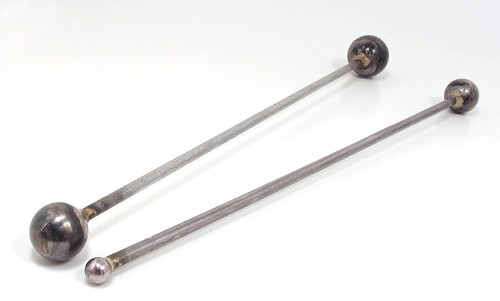A daily updated blog typed by someone with painty hands, oil under his fingernails and the smell of solder in his nostrils who likes making all sort of models and miniatures. And fixing things.
Monday, May 11, 2015
Mystery Tool 5
I thought I'd finished the mystery tool thread, but then, in the bottom of a bag, I found these.
Each steel rod is 15cm long and on the end is brazed a steel ball. The balls vary in size and weight - 8, 13, 21 and 38 grams.
What I think they are for is reprimanding visitors to exhibitions from behind the safety of a model railway layout. When the nasal whine gets too annoying, hold one end and swing the other so it hits the cause of the problem on the top of his bonce.
The weight swung will depend on the level of annoyance. For a particularly ripe, backpack wielding problem, I recommend the 38g thwack.
Some of you may with to suggest alternative uses for these, if so, please do this in the comments. Be careful though, I am now armed!

Not so much weights as sizes, perhaps? As in go/no-go gauges.
ReplyDeleteSome kind of brass forming tools perhaps, for forming tumblehomes by rubbing the tools along the brass sides? I've seen a description on a forum, by Larry Goddard, of tumblehomes formed in such a way with the blunt end of a scalpel handle. That would eplain the handle and the different sized ends.
ReplyDeleteAlthough they would be excellent for smacking the hands of exhibition visitors who don't understand 'please do not touch'!
Or the heads of smart-alecs...
Interesting idea - I'd not thought of that. Sizes are 6.2, 14.2, 15 and 20mm.
ReplyDeleteI also wondered if they were something to do with checking safety on prototype cars (John worked for Rover on this sort of thing) as I know that for Single Vehicle Lisencing tests, there are spheres used to check if fingers will get caught in door gaps etc.
For forming flares on the bottoms of domes and chimneys after turning?
ReplyDeleteI can't see them being used for shaping chimney/dome bases, for a start they are too big, at least for 4mm scale work.
ReplyDeleteThere are two main ways to form the base of boiler fittings.
The first involves shaping the underside of the base (where it meets the boiler) either by fly-cutting or filing, then finishing the sides with a file. My attempt in OO9 can be seen here: http://paulthehalfwit.blogspot.co.uk/2014/06/turning-chimney-for-my-small-quarry.html
Or the base is drilled out and 'bell mouthed', i.e. removing as much material as possible, then the base is squashed against a suitable diameter piece of rod. Again my attempt is seen here: http://paulthehalfwit.blogspot.co.uk/2014/06/turning-chimney-for-oo9-waril-class.html